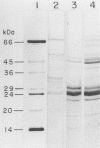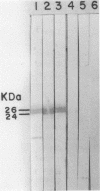Abstract
We previously identified three immunodominant antigens obtained from a Nocardia brasiliensis cell extract and recognized by sera from mycetoma patients (M. C. Salinas-Carmona, L. Vera, O. Welsh, and M. Rodríguez, Zentralbl. Bakteriol. 276:390-397, 1992). In the present work, we obtained a crude extract from a mass culture of N. brasiliensis HUJEG-1 and purified two immunodominant antigens, the 26- and 24-kDa proteins, by using simple physiochemical techniques. With these antigens, we developed a conventional solid-phase enzyme-linked immunosorbent assay and tested 30 serum samples from mycetoma patients, 29 from tuberculosis patients, 24 from a leprosy group, and 31 from healthy individuals. Our results show for the first time statistically significant differences in serology among these groups. All mycetoma patients with a positive culture for N. brasiliensis had absorbance values higher than 0.3. On the other hand, the mycobacterium-infected patients as well as the healthy individuals all had absorbance values below that level. Moreover, we found a close correlation between the clinical condition of the mycetoma patients and the anti-26- and anti-24-kDa protein antibody concentrations. We therefore propose the use of this assay in routine clinical laboratories to confirm the diagnosis of N. brasiliensis infection in human mycetoma cases. In addition, the possible application of this assay in the serodiagnosis of Nocardia asteroides infection is also discussed.
Full text
PDF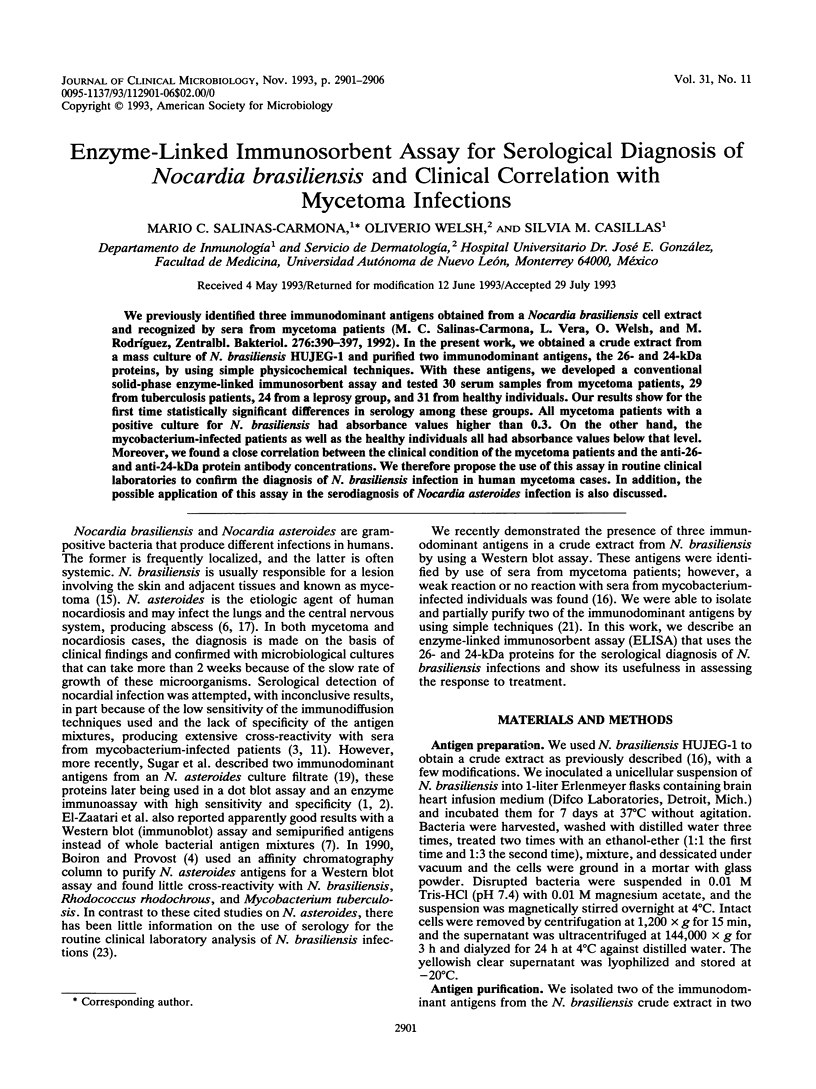
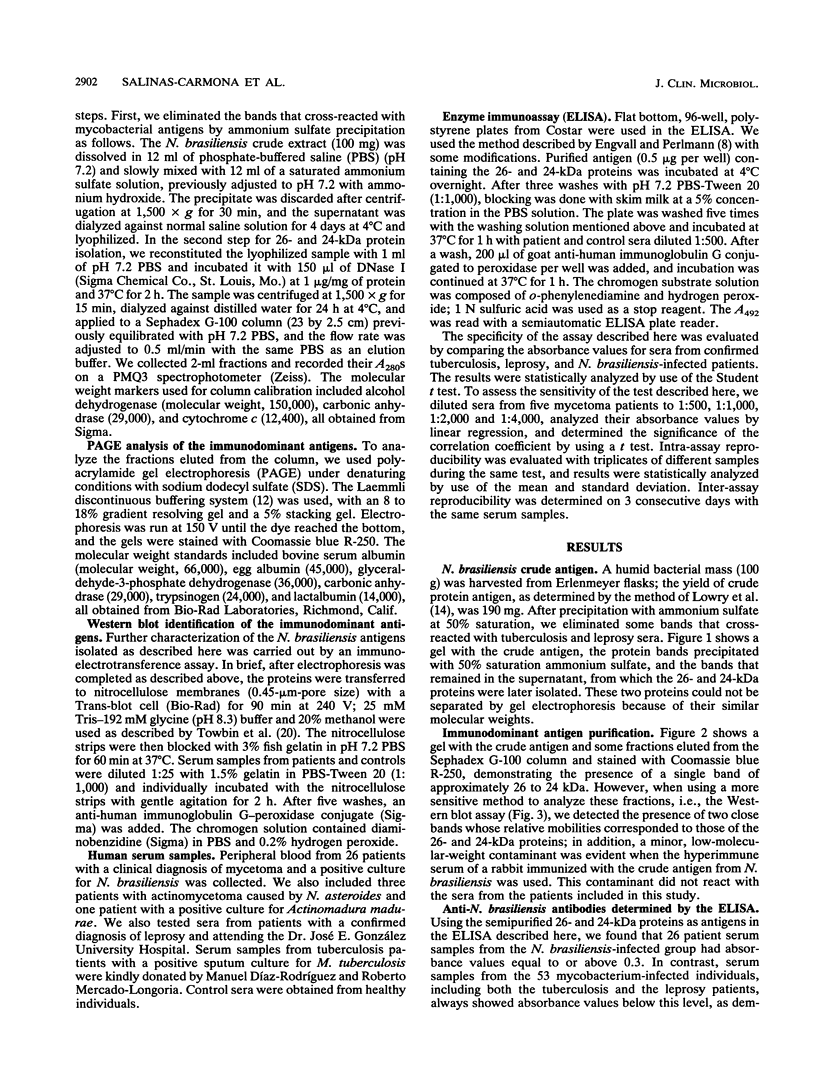
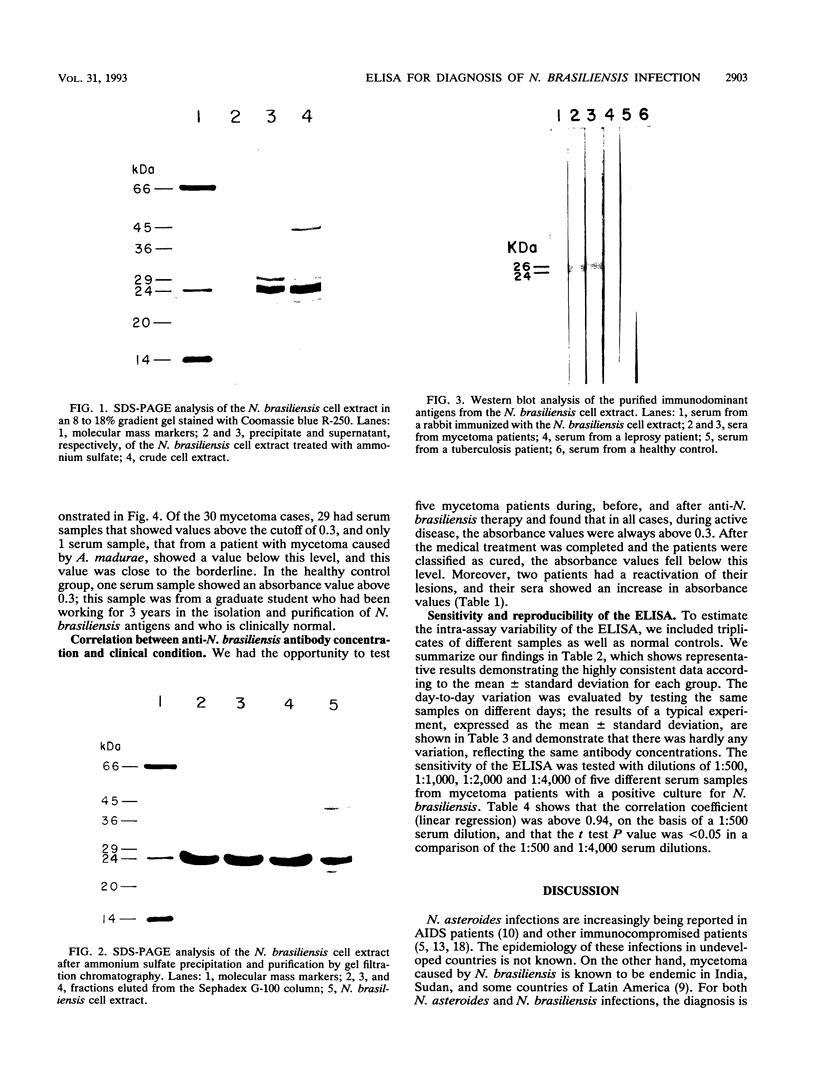
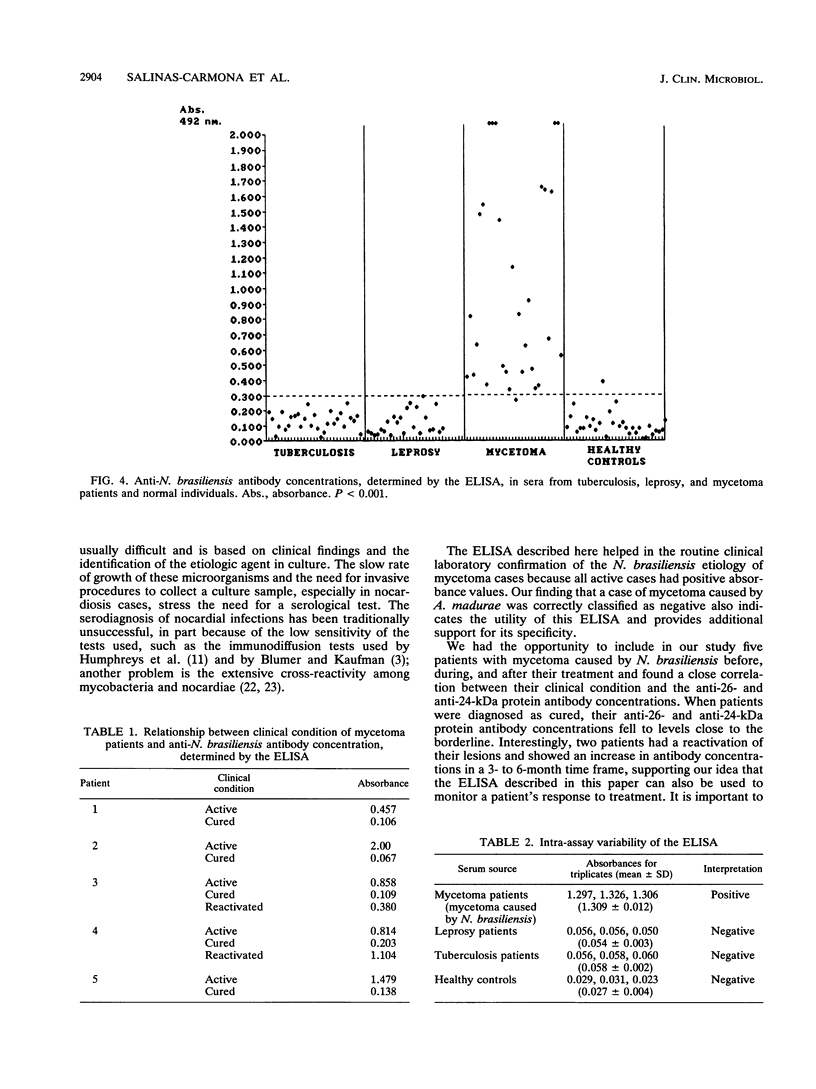
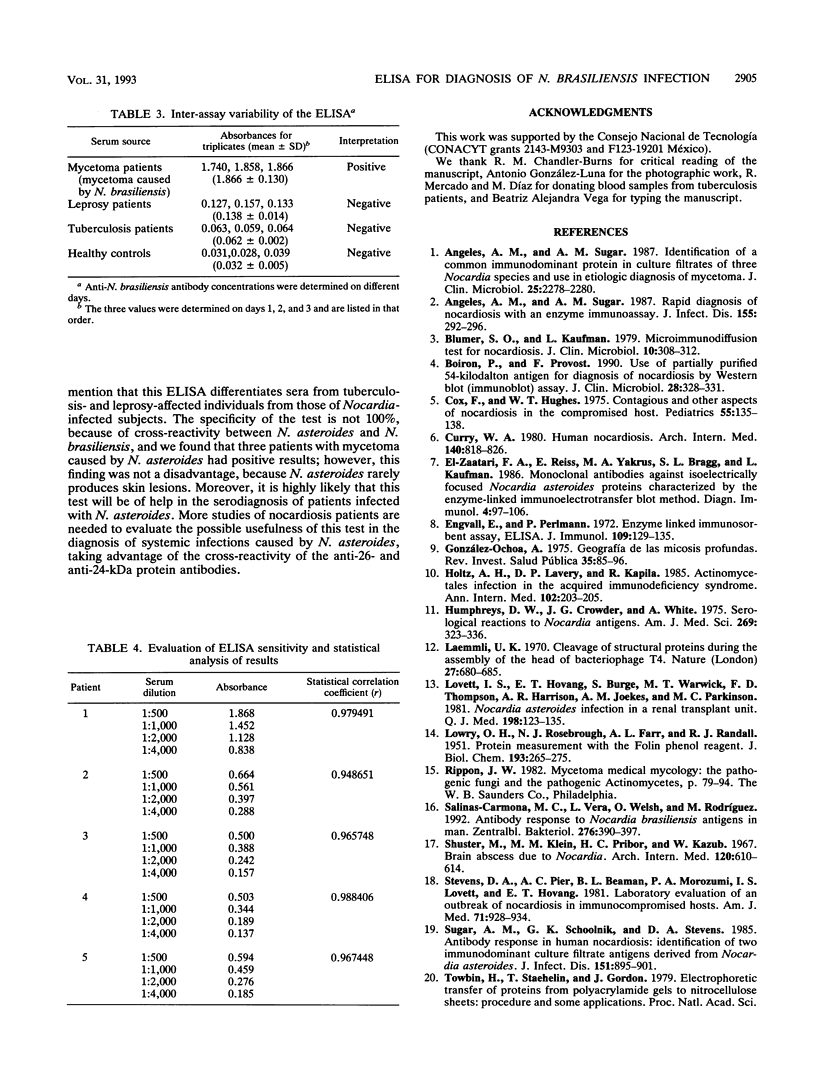
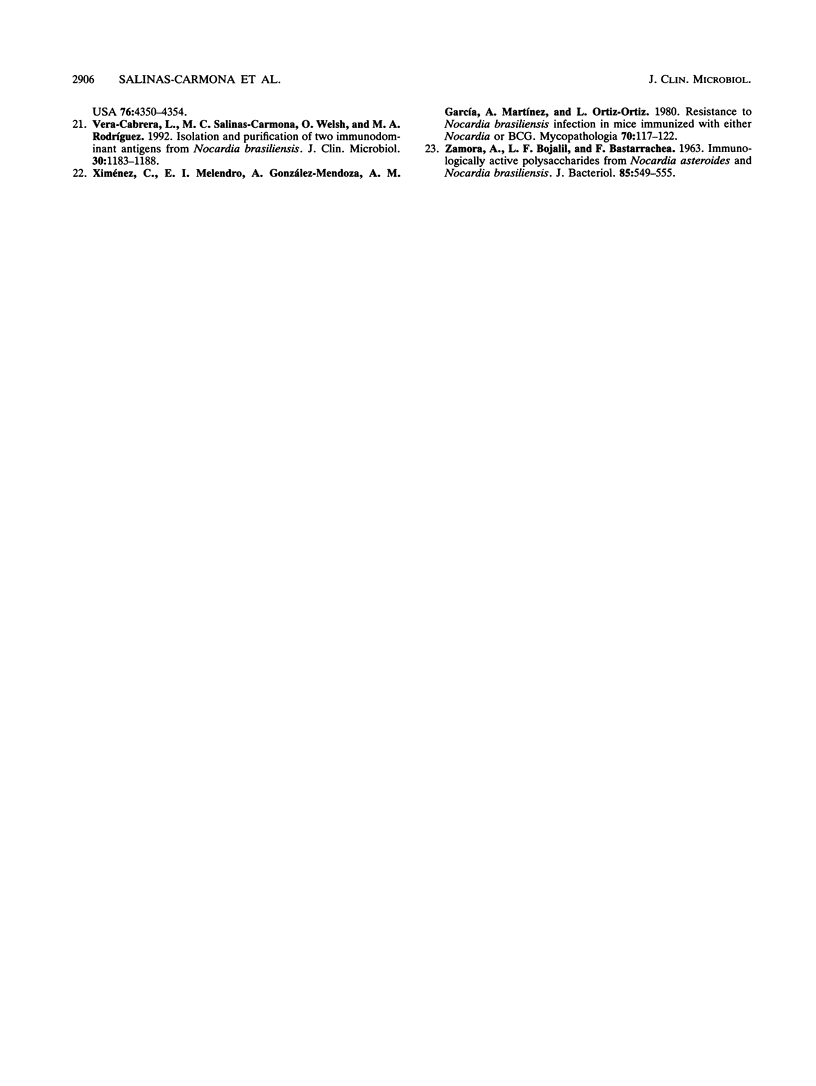
Images in this article
Selected References
These references are in PubMed. This may not be the complete list of references from this article.
- Angeles A. M., Sugar A. M. Identification of a common immunodominant protein in culture filtrates of three Nocardia species and use in etiologic diagnosis of mycetoma. J Clin Microbiol. 1987 Dec;25(12):2278–2280. doi: 10.1128/jcm.25.12.2278-2280.1987. [DOI] [PMC free article] [PubMed] [Google Scholar]
- Angeles A. M., Sugar A. M. Rapid diagnosis of nocardiosis with an enzyme immunoassay. J Infect Dis. 1987 Feb;155(2):292–296. doi: 10.1093/infdis/155.2.292. [DOI] [PubMed] [Google Scholar]
- Blumer S. O., Kaufman L. Microimmunodiffusion test for nocardiosis. J Clin Microbiol. 1979 Sep;10(3):308–312. doi: 10.1128/jcm.10.3.308-312.1979. [DOI] [PMC free article] [PubMed] [Google Scholar]
- Boiron P., Provost F. Use of partially purified 54-kilodalton antigen for diagnosis of nocardiosis by Western blot (immunoblot) assay. J Clin Microbiol. 1990 Feb;28(2):328–331. doi: 10.1128/jcm.28.2.328-331.1990. [DOI] [PMC free article] [PubMed] [Google Scholar]
- Cox F., Hughes W. T. Contagious and other aspects of nocardiosis in the compromised host. Pediatrics. 1975 Jan;55(1):135–138. [PubMed] [Google Scholar]
- Curry W. A. Human nocardiosis. A clinical review with selected case reports. Arch Intern Med. 1980 Jun;140(6):818–826. doi: 10.1001/archinte.140.6.818. [DOI] [PubMed] [Google Scholar]
- Engvall E., Perlmann P. Enzyme-linked immunosorbent assay, Elisa. 3. Quantitation of specific antibodies by enzyme-labeled anti-immunoglobulin in antigen-coated tubes. J Immunol. 1972 Jul;109(1):129–135. [PubMed] [Google Scholar]
- González-Ochoa A. Geografía de las micosis profundas. Rev Invest Salud Publica. 1975 Jan-Mar;35(1):85–96. [PubMed] [Google Scholar]
- Holtz H. A., Lavery D. P., Kapila R. Actinomycetales infection in the acquired immunodeficiency syndrome. Ann Intern Med. 1985 Feb;102(2):203–205. doi: 10.7326/0003-4819-102-2-203. [DOI] [PubMed] [Google Scholar]
- Humphreys D. W., Crowder J. G., White A. Serological reactions to Nocardia antigens. Am J Med Sci. 1975 May-Jun;269(3):323–326. doi: 10.1097/00000441-197505000-00005. [DOI] [PubMed] [Google Scholar]
- LOWRY O. H., ROSEBROUGH N. J., FARR A. L., RANDALL R. J. Protein measurement with the Folin phenol reagent. J Biol Chem. 1951 Nov;193(1):265–275. [PubMed] [Google Scholar]
- Laemmli U. K. Cleavage of structural proteins during the assembly of the head of bacteriophage T4. Nature. 1970 Aug 15;227(5259):680–685. doi: 10.1038/227680a0. [DOI] [PubMed] [Google Scholar]
- Lovett I. S., Houang E. T., Burge S., Turner-Warwick M., Thompson F. D., Harrison A. R., Joekes A. M., Parkinson M. C. An outbreak of Nocardia asteroides infection in a renal transplant unit. Q J Med. 1981 Spring;50(198):123–135. [PubMed] [Google Scholar]
- Salinas-Carmona M. C., Vera L., Welsh O., Rodríguez M. Antibody response to Nocardia brasiliensis antigens in man. Zentralbl Bakteriol. 1992 Feb;276(3):390–397. doi: 10.1016/s0934-8840(11)80546-3. [DOI] [PubMed] [Google Scholar]
- Shuster M., Klein M. M., Pribor H. C., Kozub W. Brain abscess due to Nocardia. Report of a case. Arch Intern Med. 1967 Nov;120(5):610–614. [PubMed] [Google Scholar]
- Stevens D. A., Pier A. C., Beaman B. L., Morozumi P. A., Lovett I. S., Houang E. T. Laboratory evaluation of an outbreak of nocardiosis in immunocompromised hosts. Am J Med. 1981 Dec;71(6):928–934. doi: 10.1016/0002-9343(81)90302-8. [DOI] [PubMed] [Google Scholar]
- Sugar A. M., Schoolnik G. K., Stevens D. A. Antibody response in human nocardiosis: identification of two immunodominant culture-filtrate antigens derived from Nocardia asteroides. J Infect Dis. 1985 May;151(5):895–901. doi: 10.1093/infdis/151.5.895. [DOI] [PubMed] [Google Scholar]
- Vera-Cabrera L., Salinas-Carmona M. C., Welsh O., Rodriguez M. A. Isolation and purification of two immunodominant antigens from Nocardia brasiliensis. J Clin Microbiol. 1992 May;30(5):1183–1188. doi: 10.1128/jcm.30.5.1183-1188.1992. [DOI] [PMC free article] [PubMed] [Google Scholar]
- Ximénez C., Melendro E. I., González-Mendoza A., García A. M., Martínez A., Ortiz-Ortiz L. Resistance to Nocardia brasiliensis infection in mice immunized with either Nocardia or BCG. Mycopathologia. 1980 Mar 17;70(2):117–122. doi: 10.1007/BF00443077. [DOI] [PubMed] [Google Scholar]
- ZAMORA A., BOJALIL L. F., BASTARRACHEA F. IMMUNOLOGICALLY ACTIVE POLYSACCHARIDES FROM NOCARDIA ASTEROIDES AND NOCARDIA BRASILIENSIS. J Bacteriol. 1963 Mar;85:549–555. doi: 10.1128/jb.85.3.549-555.1963. [DOI] [PMC free article] [PubMed] [Google Scholar]
- el-Zaatari F. A., Reiss E., Yakrus M. A., Bragg S. L., Kaufman L. Monoclonal antibodies against isoelectrically focused Nocardia asteroides proteins characterized by the enzyme-linked immunoelectro-transfer blot method. Diagn Immunol. 1986;4(2):97–106. [PubMed] [Google Scholar]



